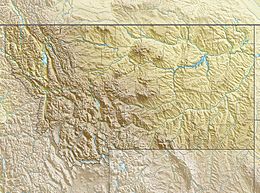Lake Sherburne Dam facts for kids
Quick facts for kids Lake Sherburne Dam |
|
|---|---|
|
Location of Lake Sherburne Dam in Montana
|
|
| Country | United States |
| Location | Glacier County, near Glacier National Park, Montana |
| Coordinates | 48°49′41.85″N 113°31′16.94″W / 48.8282917°N 113.5213722°W |
| Construction began | 1914 |
| Opening date | 1921 |
| Owner(s) | U.S. Bureau of Reclamation |
| Dam and spillways | |
| Type of dam | Earth embankment |
| Impounds | Swiftcurrent Creek |
| Height | 116.5 feet (35.5 m) |
| Length | 1,224 feet (373 m) |
| Width (crest) | 24 feet (7.3 m) |
| Width (base) | 460 feet (140 m) |
| Dam volume | 242,000 cubic yards (185,000 m3) |
| Spillways | One morning glory type, uncontrolled |
| Spillway capacity | 2,100 cubic feet per second (59 m3/s) |
| Reservoir | |
| Creates | Lake Sherburne |
| Total capacity | 64,793 acre-feet (79,921,000 m3) |
| Surface area | 17,300 acres (7,000 ha) |
| Power station | |
| Hydraulic head | 99 feet (30 m) |
Lake Sherburne Dam is a large earth dam located in Montana, very close to Glacier National Park. It was built between 1914 and 1921. The dam creates a reservoir called Lake Sherburne, which stretches into the national park.
The dam holds back the waters of Swiftcurrent Creek as it flows out of the park. Water from Lake Sherburne is released into Swiftcurrent Creek, which then flows into the St. Mary River. From there, some water is sent to the Milk River. The Milk River travels through Canada for about 216 miles (348 km) before returning to the United States.
The way these waters are shared between the U.S. and Canada is managed by an agreement called the Boundary Waters Treaty of 1909. The water from the Milk River is mainly used to help farmers water their crops in north-central Montana.
Contents
Building the Dam: A Big Project
The main goal of the Milk River Project was to store water for irrigation. Engineers first looked at the St. Mary Lakes for a dam site. These lakes include Upper St. Mary Lake inside Glacier National Park and Lower St. Mary Lake just outside. However, they couldn't find a good place to build a dam there.
So, they chose the Sherburne Lakes in Swiftcurrent Valley as the new location. Construction on the dam began in 1914. Workers used earth and materials from the upper part of the Sherburne Lakes to build the dam.
Moving Materials and Early Challenges
To make it easier to move building supplies, a small tug boat and several barges were bought. These were transported all the way overland from Seattle to the dam site. Work continued steadily through 1915 and 1916.
In April 1916, Swiftcurrent Creek was redirected to flow through the dam's new outlet system. However, spring floods often caused delays and made the work harder.
Spillway Issues and Solutions
The outlet tower and gatehouse, which control water flow, were built in 1917. The spillway, designed to release excess water, was also constructed that year. But in October, engineers noticed a problem: the spillway was moving because of a landslide on a nearby hill. Even draining lakes above the slide didn't fix the issue.
Work on the dam and its controls continued into 1918, but the spillway problems persisted. To allow for this movement, the spillway walls and floor were eventually built using flexible wood timbers. Water storage in Lake Sherburne officially began in 1919, and the entire project was finished in 1921. When it was first built, Lake Sherburne held about 66,100 acre-feet (81,500,000 m3) of water behind the 94-foot (29 m) dam.
Upgrades in the 1960s
In 1960, the original spillway at the north end of the dam was filled in because of the ongoing landslide problems. A new, improved spillway was built instead. This new spillway uses a special circular overflow design, often called a "morning glory" type, located out in the lake. It releases water into the lower part of the dam's outlet system.
At the same time, the top of the dam was raised by 20 feet (6.1 m). This was done to make sure water wouldn't flow over the dam during very large floods. A 24 feet (7.3 m) high wall was also added on top of the dam. This wall was made using unique interlocking concrete blocks, filled with compacted earth between them. This was the first time the Bureau of Reclamation used this building method. The outlet works and spillway were also made taller during this upgrade.
How the Dam Works Today
Lake Sherburne Dam helps manage the water flow in Swiftcurrent Creek. There isn't a rule that says a certain amount of water must always be released from the lake. Because of this, the creek can sometimes have very little or no water flowing in it from November through February.


